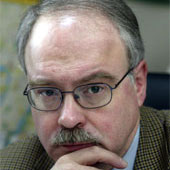Getting Russia Right
As the Medvedev era begins, what is the outlook for the Russian Federation?
May 8, 2008
How do you think people view Russia?
“Russia has a reputation of being a land of extremes. Even analysis of Russia could suffer from that affliction.
“In the last two decades, many inside players and outside observers hoped that Russia would change not only profoundly, but, in effect overnight. These overly optimistic expectations were soon dashed, only to be replaced with deep disillusionment and pessimism about Russia.”
What is Russia’s government like?
“Officially known as a federation, Russia is in reality closer to a unitary state, with the governors of the country’s seven dozen regions appointed and dismissed by the president.”
Is Russia today similar to the Soviet Union?
“Today’s Russia is different from the Soviet Union in so many ways that the idea of a USSR Version 2.0 would seem preposterous to any objective observer of Russia. Of the things that have brought about that irreversible change, two stand out. One is money, which has become virtually the center of everything in today’s Russia. The other one is Russia’s openness to the outside world.”
How has Russia changed in the last few decades?
“The lasting change in Russia at the turn of the 1990s was not the advent of democracy, but the introduction and institutionalization of money and of everything it brings with it.”
Tell us more about the instutionalization of money.
“Ever since the New Economic Policy had been phased out in the late 1920s, together with gold and silver coins, the Soviet Union had been a country which had no use for real money. Of course, ruble notes were duly printed and national budgets regularly approved, but central to the Soviet economy was the allocation of nonmonetary resources.”
How has the Russian economy changed since the Soviet Union?
“In the Soviet Union, the most valuable piece of personal property was a car, costing 50 to 100 times the average monthly salary.
“As of 2007, the number of cars in Moscow has reached three million, making the city of ten million people virtually impassable at any time.”
Does that lead to a lot of car accidents?
“In Russia, though 35,000 die in road collisions each year, between 500,000 and 700,000 people die of alcoholism or alcohol-related causes.”
Are there great wealth disparities in Russia?
“There are huge disparities. The income of the top 10% is 15 times larger than the income of the bottom 10%.”
Could you break that down even further?
“At the top, there are about 3% who are wealthy people, and 7% who are doing well. Below them, some 20% can be described as the emerging middle class. At the bottom of the social pyramid, at least 20% are poor.”
What about the 50% you haven’t described — those below the emerging middle class and above the poor?
“It is those in the middle of the societal structure, roughly 50% of the population, who are caught in transition. Most of them should be able to make it to the middle class group. Should this happen, it would stabilize society enormously and seal Russia’s success. However, if they were to sink into the poor underclass, Russia would find itself in dire straits. The stakes could not be higher.”
Do you think Russia has had more trouble than usual transitioning away from an empire?
“Exiting from empire is never easy. After a period of shock and intense humiliation, national resurgence follows. In contrast to France and Britain, Russia’s immediate post-imperial existence has not been accompanied and compensated for by integration into a larger entity such as the European Community and the Atlantic Alliance. The predictable result is a palpable rise in modern Russian nationalism.”
Is Russia still as large as it was under the Soviet Union?
“Russia is no longer the fourth-largest nation in the world, as the USSR was (behind China and India and close enough to the third-place United States). With 143 million inhabitants and falling, the Russian Federation has fallen to ninth place. Bangladesh and Pakistan have overtaken it.
“If current trends continue, Russia’s population will drop to approximately 100 million by 2050 — fewer people than Iran. However, even 100 million in 2050 would be the equivalent of the 1950 population of the Russian Soviet republic.”
Where did those people go?
“Three countries — Israel, Germany and the United States — each have become home to over a million former Soviet nationals.
“There are about 20 million ethnic Russians in the former borderlands — such as the Crimea, where they form a two-thirds majority, or in eastern and southern Ukraine, or northern Kazakhstan — who are not Russian citizens.”
So, do you think the Russian Federation will break up soon?
“A breakup of the Russian Federation is not in the cards. A world without Russia is a fantasy. It would be wrong to describe Russia’s current state as decline simply by comparing its raw power and international influence with that of its Soviet predecessor. A more adequate description would be reconstitution, in which the very foundations of society are undergoing a change.”
Takeaways
"A breakup of the Russian Federation is not in the cards. A world without Russia is a fantasy."
"The lasting change in Russia at the turn of the 1990s was not the advent of democracy, but the introduction and institutionalization of money and of everything it brings with it."
"At the top, there are about 3% who are wealthy people, and 7% who are doing well. Below them, some 20% can be described as the emerging middle class. At the bottom of the social pyramid, at least 20% are poor."
"Today's Russia is different form the Soviet Union in so many ways that the idea of a USSR Version 2.0 would seem preposterous to any objective observer of Russia."
